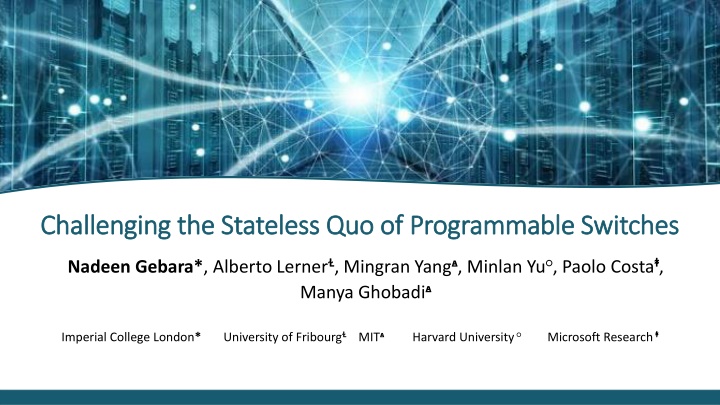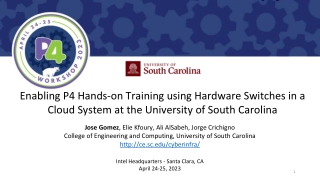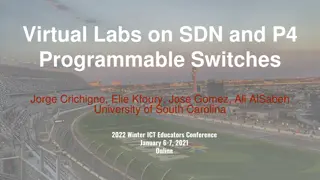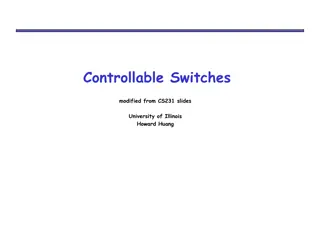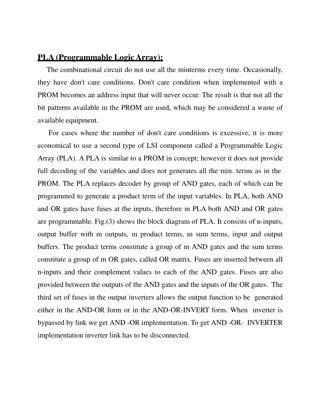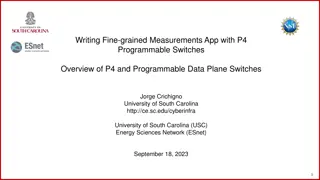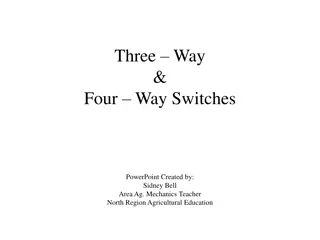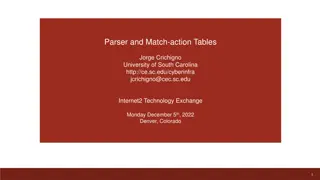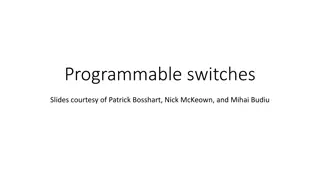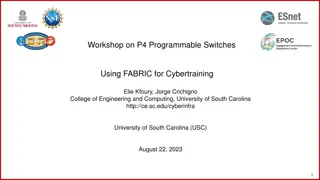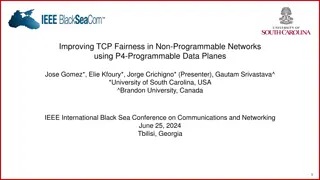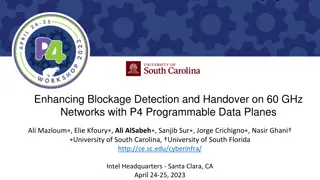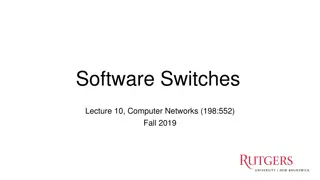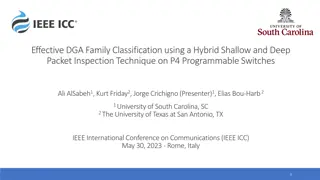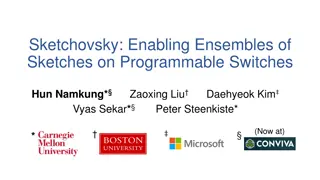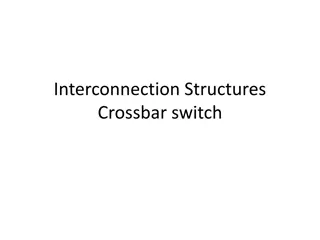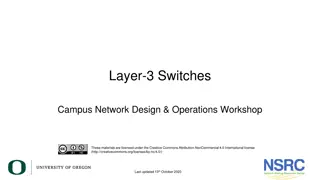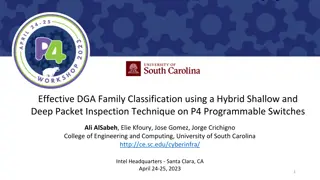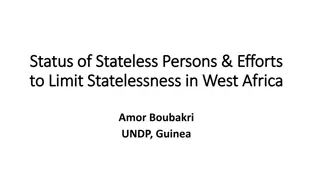Challenging the Stateless Quo of Programmable Switches
Protocol Independent Switch Architecture (PISA) challenges the conventional stateless approach with innovative concepts like Pipeline Match Table Configuration, Data Plane Deparser, and Programmable Switch Scheduler. Motivated by the potential for in-network applications to improve service latency and network efficiency, this research by Nadeen Gebara and team explores new horizons in networking technology.
Download Presentation

Please find below an Image/Link to download the presentation.
The content on the website is provided AS IS for your information and personal use only. It may not be sold, licensed, or shared on other websites without obtaining consent from the author.If you encounter any issues during the download, it is possible that the publisher has removed the file from their server.
You are allowed to download the files provided on this website for personal or commercial use, subject to the condition that they are used lawfully. All files are the property of their respective owners.
The content on the website is provided AS IS for your information and personal use only. It may not be sold, licensed, or shared on other websites without obtaining consent from the author.
E N D
Presentation Transcript
Challenging the Stateless Quo of Programmable Switches Challenging the Stateless Quo of Programmable Switches Nadeen Gebara*,Alberto Lerner , Mingran Yang , Minlan Yu , Paolo Costa , Manya Ghobadi University of Fribourg MIT Harvard University Microsoft Research Imperial College London*
Protocol Independent Switch Architecture (PISA) Pipeline Match Table Configuration Control plane Data plane Deparser Parser Match-Action Units 2
Protocol Independent Switch Architecture (PISA) Pipeline Data plane Packet Header Vector Packet Deparser Parser Payload Bus 3
Protocol Independent Switch Architecture (PISA) Pipeline Data plane State S E L E C T O R Deparser Parser Match Tables Action Unit Match-Action Unit Stage1 4
Protocol Independent Switch Architecture (PISA) Pipeline Data plane Feed-forward Transfer State S E L E C T O R Deparser Parser Match Tables Action Unit Match-Action Unit Stage1 Simple Operations 5
Protocol Independent Switch Architecture (PISA) Pipeline Shared-nothing Stages Data plane Feed-forward Transfer State S E L E C T O R Deparser Parser Match Tables Action Unit Match-Action Unit Stage1 6
PISA Switch Scheduler Ingress Egress Pipeline1 Deparser Parser PipelineN PipelineN Independent pipelines 7
PISA Enabled a Wave of In-network Applications 8
Motivation for In-network Applications Cache Hit Lower Service Latency [SOSP 17] RESPONSE Higher Application Throughput and Lower Network Load [SOSP 17, HotNets 17, HotNets 19] REQUEST Programmable Switches Running In-network Applications 9
Motivation for In-network Applications Lower Service Latency [NSDI 16, SOSP 17, SIGMOD 20] Higher Application Throughput and Lower Network Load [SOSP 17, HotNets 17, HotNets 19] Simpler Distributed System Co-ordination [OSDI 16, NSDI 18, OSDI 20] Improved Telemetry [SOSR 17, SIGCOMM 20] Programmable Switches Running In-network Applications 10
In-network Applications vs. Packet Protocols Defining Features In-Network Applications Packet-protocol Programs Natural Abstraction Data-structure operations Match-action rules Central Unit State Packet headers 11
Is PISA the Right Architecture for In-network Applications? 12
In-network Applications on PISA State Data plane Application State S E L E C T O R Packet Deparser Parser Match Tables Action Unit Match-Action Unit Stage1 13
1. Limited Support for Complex Operations Within a Stage State Data plane S E L E C T O R Deparser Parser Match Tables Action Unit Match-Action Unit Stage1 14
1. Limited Support for Complex Operations Within a Stage Application data structure distributed across stages and constrained by number of stages S E L E C T O R S E L E C T O R S E L E C T O R S E L E C T O R Deparser Parser Stage3 StageN Stage1 Stage2 15
2. Shared-nothing Stage Architecture Packet Header Vector used to transfer state and unroll operation across stages S E L E C T O R S E L E C T O R S E L E C T O R S E L E C T O R Deparser Parser Stage3 StageN Stage1 Stage2 16
2. Shared-nothing Stage Architecture S E L E C T O R S E L E C T O R S E L E C T O R S E L E C T O R Deparser Parser Stage3 StageN Stage1 Stage2 17
3. Feed-forward State Transfer S E L E C T O R S E L E C T O R S E L E C T O R S E L E C T O R Deparser Parser Stage3 StageN Stage1 Stage2 18
3. Feed-forward State Transfer Backward state updates can only be completed through recirculation S E L E C T O R S E L E C T O R S E L E C T O R S E L E C T O R Deparser Parser Stage3 StageN Stage1 Stage2 19
4. Programming with Fixed Memory Access Patterns Programmer must consider physical mapping A B S E L E C T O R S E L E C T O R S E L E C T O R S E L E C T O R Deparser Parser Stage3 StageN Stage1 Stage2 20
5. No State-sharing Across Pipelines Must traverse scheduler again for routing Scheduler Ingress Egress Pipeline1 Deparser Parser Packet PipelineN PipelineN 21
Rethinking Programmable Switches for In-network Applications? 22
Potential Approaches More intuitive programming languages [P4All, HotNets 20] - Applications still constrained by the architecture itself Supporting more complex operations within a stage [Domino, SIGCOMM 16] - Area overhead - Applications still constrained by other pipeline limitations Making state accessible from multiple stages/pipelines [dRMT, SIGCOMM 17] - Complex Interconnect - Hard to support Mixing MAU stages and other configurable stages in a pipeline [Taurus ; FlowBlaze, NSDI 19] - Increased packet cut-through latency - Complex pipelines 23
Proposed Approach PISA Pipeline Packet-protocol Programs S E L E C T O R Deparser Match-action abstraction Parser Match Tables Action Unit Packet headers centric Stage1 24
Proposed Approach PISA Pipeline Packet-protocol Programs S E L E C T O R Deparser Match-action abstraction Parser Match Tables Action Unit Packet headers centric Stage1 Stateful Pipeline Data Structure Instance Block 1 In-network Applications Stateful Queue Stateful Queue Data-structure specific instances can be designed optimally unlike a generic pipeline More natural abstraction and flexible data structure operations Support for parallel execution Simpler shared state management and synchronization Data structure abstraction App Bus Packet Reorder State centric Data Structure Instance Block 4 25
Proposed Approach PISA Pipeline Data plane Slack time S E L E C T O R Time for headers to traverse PISA pipeline Deparser Parser Match Tables Action Unit Stage1 Stateful Pipeline Data Structure Instance Block 1 Stateful Queue Stateful Queue App Bus Packet Reorder Data Structure Instance Block 4 26
Summary In-network applications are fundamentally different from packet- protocols Supporting in-network applications on PISA is both challenging and limited An exciting opportunity to rethink the architecture of switches for in-network applications Research Agenda Data structure instance blocks Performance- cost trade-offs State mapping and synchronization Software & compiler support 27
Integration options System-in-Package (SiP) 2.5D & 3D Chip stacking solutions (already used by some FPGAs 28
There are two dimensions Pipelining P a r a l l e l i s m More stateful operations within slack time 29
Design Choices A. Pure Logic-based approach B. Generic parallel cores with custom data structure instance blocks and synchronization C. Custom processor cores 30
B. Generic parallel cores with custom data structure instance blocks and synchronization Each core executes data structure operations of packet to completion Core Scheduler 32
C. Custom cores Similar in theory to previous idea, but more flexible register files and forwarding logic in cores Cores execute multiple packets simultaneously (State loaded into core s register file and kept in register per-stage) (Synchronization still needed across cores/ special synch instructions) Compounded operations 33
Questions Build on FPGA to start prototyping blocks Consider multiple blocks and data-structure specific ISA cores with memory mappings How are you going to fit on the same-die ? {intel technology) Throughput and pipelining Programmability if not FPGA How is this different from externs {externs are limited to within the stage} 34
My questions Programmable Parser ~ 40 Gbps Application bus might become bottleneck ? Each parser connected to one queue Order of scheduling and slack ? More on deparser 35
FPGA specs 36
